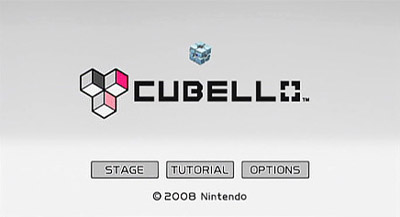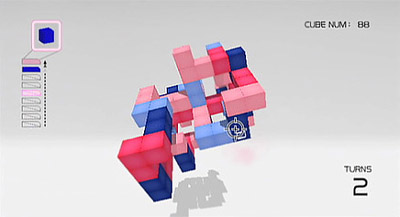
Cubello is one of Nintendo’s “Art Style” games, a franchise of simple puzzle games (mostly developed by skip Ltd.) with stylish minimalist presentation that developed from the “bit Generations” series which accompanied the launch of the Game Boy Micro. It’s currently available to purchase through the Wii Shop Channel* in Europe and North America for a very reasonable 400 Wii Points (about three quid).
While Cubello might not be that remarkable in itself, its a good example of the sort of game that wouldn’t have been possible before Nintendo’s Wii-reinvention. During the last hardware generation, Nintendo not only had no online strategy, but also no satisfactory way to sell small games. (Their much-maligned offering of NES games for the GBA as individual cartridges being typical of their approach.) They’ve since embraced digital distribution for both the Wii and DSi.
What’s more, Cubello’s interface is built around the Wii Remote’s cursor function. There has been surprisingly little recognition of the significance of this aspect of the Wii’s controls. Making a pointing device work from the sofa is a prize that has eluded console manufacturers for decades, confining many mouse-driven games and genres to the PC. While the Wii Remote is marginally less responsive and accurate than a mouse, it’s light years ahead of an analogue joystick for pointing (and aiming, and drag-and-drop) tasks.
So anyway, what is it that you do with the cursor in this cheap yet stylish game?

Each level of Cubello (of which there are 36, along with an ‘Endless’ mode) presents you with a structure of coloured cubes spinning slowly in space. The aim of the game is to fire cubes at the structure which then stick to it. When four or more like-coloured cubes are connected they fall off the structure, and the player is rewarded with some more cubes to fire (represented in the ‘magazine’ on the left of the screen). The aim of the game is to remove all the cubes from the structure without running out of ‘ammo’.
This task would be trivial if the rotation of the structure was under the player’s control, but of course it isn’t. Each fired cube that collides with the structure changes the direction of rotation. Often the speed of rotation results in a brief time window when the face that you’re trying to hit is visible to the camera. The challenge then becomes to spot an appropriate target and to deftly line up and fire your shot.
If that wasn’t enough, the structure slowly moves towards the camera (only being pushed back by successful eliminations), eventually colliding with it, incurring a (usually terminal) penalty for dawdlers. It’s possible to recover from a few mistakes, but as with Tetris, as the pressure mounts the margin for error drops off. There’s also a ‘Bonus Time’ mode which occasionally kicks in, allowing the player to fire an unlimited number of cubes of the same colour for a few seconds, which is extremely effective in the hands of skilled players.
The experience of playing Cubello is a strange one. It does so many things that are on the verge of being intolerably aggravating, and yet still manages to be almost hypnotically engrossing to play. More than one review has assumed that the game is random to the point of being unfair, but this isn’t the case. It’s always possible to complete a stage with the pieces and time you’re given – it’s just not always easy. Getting into a stalemate with the last few pieces can be exasperating. The ‘structure hitting the camera’ mechanic (with accompanying bird-hitting-the-windscreen sound effect and camera shake) is genuinely unpleasant to experience.
The speech-synthesised narrator voice (which robotically announces every single event in the game: “LAUNCH CYAN LAUNCH BLUE ELIMINATED LAUNCH INDIGO ELIMINATED ELIMINATED LAUNCH WHITE ELIMINATED -NIIICE!- LAUNCH BLUE…” and on, and on) while initially grating soon falls into a rhythm along with the player’s actions. The music also deserves a mention, seemingly employing a similar generative trick to that used by the Saturn game Nights and mixed with what sounds like muffled crowd noise at an airport.
In spite of these causes of anxiety, I still played the game non-stop for about a fortnight earlier this year. (The game’s longevity is left up to the player – beating the 36 levels doesn’t take long, but it’s obvious that Cubello is intended to be a high-score beating game.) At first glance it appears to be a case of style over substance, but the longer you play, the more it becomes apparent that a lot of thought has gone into every aspect of the design. This deceptive simplicity was also evident in the last game I played from this developer, Chibi-Robo!.
While I expect Cubello won’t be to everyone’s taste, at such a low price it doesn’t represent much of a risk.
*Incidentally, accessing the Wii Shop Channel requires the latest Wii firmware update, which currently prevents the Twilight Hack from being performed. If you’ve not investigated the Wii homebrew scene – and there are many (legal) reasons you might want to, including an assortment of original games, emulators and media players – WiiBrew.org will give you all the information you need to get started.
